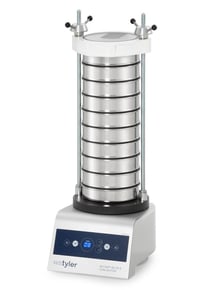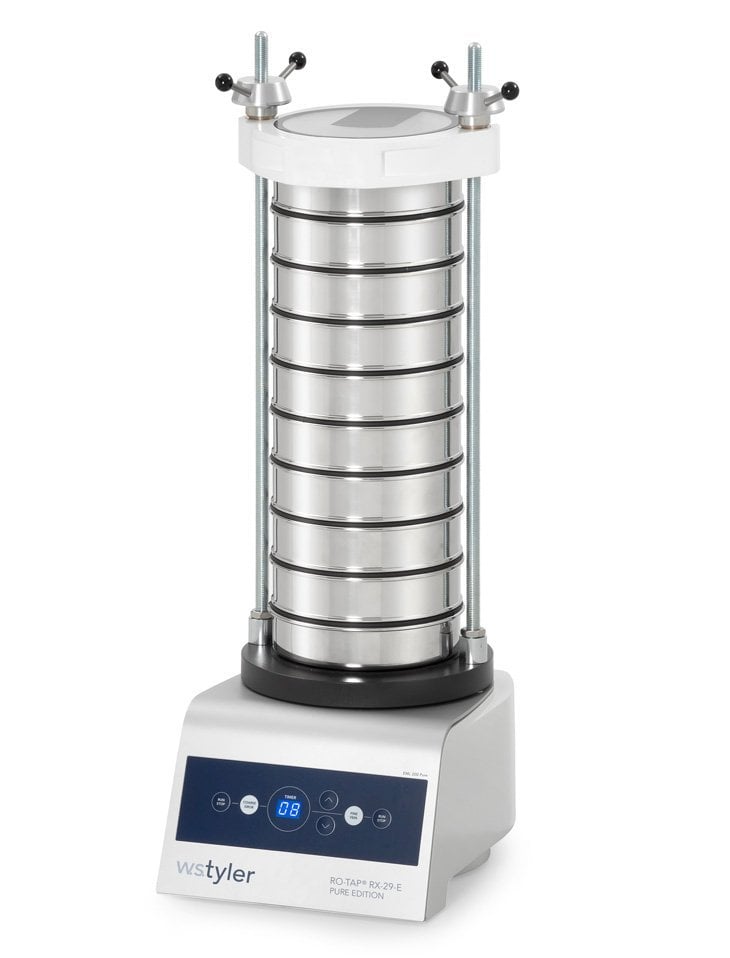W.S. Tyler RO-TAP® RX-29 vs RO-TAP E Pure
Sieve shakers, for the most part, remained untouched for decades. But as technology became an integral element of everyday life, the way we carry out test sieve analysis became more advanced.
More specifically, this advancement came in the form of a shift from traditional mechanical sieve shakers, such as the W.S. Tyler RO-TAP® RX-29, to electromagnetic sieve shakers, such as the W.S. Tyler RO-TAP E Pure. This left lab managers responsible for comparing these devices to see which one made more sense for their needs.
W.S. Tyler created the first RO-TAP device in the early 1900s and has strived to learn how its customers' operations work to help them pick the best solutions since then.
And with that, this article was written to paint a vivid picture of how the RO-TAP RX-29 and RO-TAP E Pure compare by covering:
- What the RO-TAP RX-29 is
- What the RO-TAP E Pure is
- How the two devices compare
- Determining which device makes sense for you
What Is the RO-TAP RX-29?

The W.S. Tyler RO-TAP RX-29 is W.S. Tyler's signature mechanical sieve shaker designed to apply an oscillating motion alongside brute force hammer taps to promote particle movement throughout a test sieve stack. These motions work in conjunction to help lab operators yield accurate and reputable particle analysis results in the form of a particle distribution curve.
What Is a RO-TAP E Pure?

The W.S. Tyler RO-TAP E Pure is our entry-level electromagnetically driven sieve shaker that applies elliptical vibrations to a test sieve stack to facilitate the test sieve analysis process. While the hardware used is entirely different, the RO-TAP E Pure was designed to essentially mimic the functions and performance of the RO-TAP RX-29.
How Do the RO-Tap Rx-29 and RO-Tap E Pure Compare?
While the RO-TAP RX-29 and RO-TAP E Pure are designed to produce the same end result, they are two very different devices. To get a better idea of how they stack up to one another, you must look at the following aspects:
- compatible test sieves
- how much it costs
- noise levels
- installation requirements
- Operation
- Maintenance
Test Sieve Compatibility
RO-TAP RX-29
The RO-TAP RX-29 works specifically with 8-inch test sieves. The number of sieves you can have in a test sieve is dependent on the height of the sieves' frame.
If half-height sieves are used, the test sieve stack can contain 13 sieves and a collection pan. If full-height sieves are used, the test sieve stack can contain six sieves and a collection pan.
RO-TAP E Pure
The RO-TAP E Pure is similar in the fact that it is designed for 8-inch test sieves. Again the number of sieves that can be tested falls upon whether half-height or full-height test sieves are used to assemble the test sieve stack.
The differences lay with the number of sieves.
If half-height sieves are used, the test sieve stack can contain up to 15 sieves with a collection pan. If full-height sieves are used, the test sieve stack can include up to nine sieves with a collection pan.
Cost
RO-TAP RX-29
The RO-TAP RX-29 will run you approximately $3,762.44. This price reflects the cost of the raw material needed to construct the device, thus is subject to change with the market.
RO-TAP E Pure
The RO-TAP E Pure carries an approximate price of $6,585.52 (8-inch sieve model) or $11,005.80 (12-inch sieve model). Again, this cost presents the probability of changing as it is based on raw material.
Noise Level
RO-TAP RX-29
One of the most significant drawbacks you will encounter when using the RO-TAP RX-29 is the amount of noise produced by the device. The main contributions to the noise level include the brute force hammer taps as well as the moving timing belts and gears.
The material rattling throughout the test sieve stack will also feed into the overall noise produced when conducting a test sieve analysis.
Standalone, the device can reach decimals of 85 dB; however, this can be managed and reduced to 78 dB by placing the device in a sound enclosure.
RO-TAP E Pure
The RO-TAP E Pure is significantly quieter than the RO-TAP RX-29, which is one of its key selling points. There are minimal moving parts and no brute force hammer taps, reducing the noise produced by the RO-TAP E Pure to a loud buzzing.
The RO-TAP E Pure features two testing amplitudes that will affect the noise the device produces. Additionally, like any other test sieve shaker, the particles passing through the test sieve stack will feed into the noise produced.
Installation
RO-TAP RX-29
For the most part, the RO-TAP RX-29 is a plug-and-play device. That said, it does feature a cast iron frame that makes it heavy.
To protect you and your staff, at least two people should work together when moving the device.
It should be placed on a secure table or the ground, then bolted down using the pre-drilled holes throughout the device's base. At this point, all that's left to do is plug the device in and press the start button when ready to test material.
RO-TAP E Pure
Installing the RO-TAP E Pure is slightly more involved but still relatively easy to do. To that end, it is a reasonably light sieve shaker so one person can transport it from the box.
Now, as the device doesn't feature all the moving parts of a mechanical sieve shaker, it doesn't move or shift when testing material. This means you can set it on a sturdy table away from the edge without the need to bolt it down.
You can now install and secure the two guide rods, place the sieve cover on top, and plug the device in.
Operation
RO-TAP RX-29
The RO-TAP RX-29 is very user-friendly. Naturally, if you haven't used the device before, you will need to implement an end-of-sieving analysis to calculate how long your material should be tested.
When it comes to operating the device, using the RX-29 involves inserting your test sieve stack, ensuring the height of your stack is properly adjusted, setting the run time, and pressing play.
RO-TAP E Pure
The RO-TAP E Pure utilizes an industrial magnet and spring system to displace the sieve plate and agitate the test sieve stack. This is done in place of the signature hammer tap of the RX-29.
To make up for the lack of agitating hammer taps, the RO-TAP E Pure features motion stop intervals instead. This allows the particles to compose and make their way through the mesh openings of the test sieve stack.
What this looks like is the machine will run for 30 seconds and stop for five seconds, repeating this cycle until testing is complete.
Having said that, as stated above, the RO-TAP E Pure gives operators two amplitude settings to choose from: a fine particle setting and a coarse particle setting. These settings help create a more tailored experience based on the material being tested.
To that end, much like the RX-29, to ensure you run material for long enough using the RO-TAP E Pure, you must conduct an end-of-sieving analysis before testing material.
Maintenance
RO-TAP RX-29
The RO-TAP RX-29 uses several wear and tear parts to deliver desirable performance. Most commonly, the timing belt will wear after extended use or dry rot if left stationary for extended periods.
There are also several brass bushings and bearings throughout the device that will eventually need to be replaced.
Fortunately, maintenance is user-friendly and, in most cases, can be done in-house. There are pre-assembled maintenance kits that contain all the parts that commonly wear.
RO-TAP E Pure
The RO-TAP E Pure has minimal moving parts, so there is little to no maintenance needed. You will want to keep the device, specifically the two guide rods, clean of any debris.
This will prevent the sieve cover from becoming dislodged and better your chances of obtaining accurate and repeatable results.
What Sieve Shaker Makes Sense for Me?
We have now established the ways the RO-TAP RX-29 and RO-TAP E Pure are completely different devices developed to conduct a test sieve analysis. On the matter of which one you should choose, you must look at your lab setting and the level of functionality you need.
If you work in a smaller lab setting or noise is a concern, the RO-TAP E Pure may best suit your process. This is because the RO-TAP E Pure has a noticeably smaller footprint and significantly quieter operation than the RX-29.
Additionally, if you are constantly testing different materials with varying consistencies, the amplitude preferences offered by the RO-TAP E Pure will accommodate your needs.
But suppose you are looking for a device that has been considered a gold standard to the point where it's reflected in dozens of industry standards. In that case, the RO-TAP RX-29 will deliver the tried and true results that have driven the particle size analysis industry for decades.
What Other Particle Analysis Options Are Out There?
The RO-TAP RX-29 and RO-TAP E Pure are devices designed to deliver accurate test sieve analysis results. At the same time, the differences between the two are a great example of how hard it can be to designate whether you should use a mechanical or electromagnetic sieve shaker.
But maybe sieve shakers are the answer. Perhaps other devices, such as an air jet sieve or dynamic image analyzer, will deliver the results you need, which is why your research should revolve around just one device.
For over 140 years, W.S. Tyler has helped customers across dozens of industries investigate, scrutinize, and implement various particle analysis devices to ultimately yield accurate and repeatable results.
To help you along your journey, we put together the following comparison articles to encompass the experience we have had with the leading particle analysis devices firsthand and give you a better idea of what may work best for your specific needs:
About Ronnie Brown
Ronnie is the Content Writer for W.S. Tyler and has four years of experience as a professional writer. He strives to expand his knowledge on all things particle analysis and woven wire mesh to leverage his exceptional writing and graphic design skills, creating a one-of-a-kind experience for customers.





